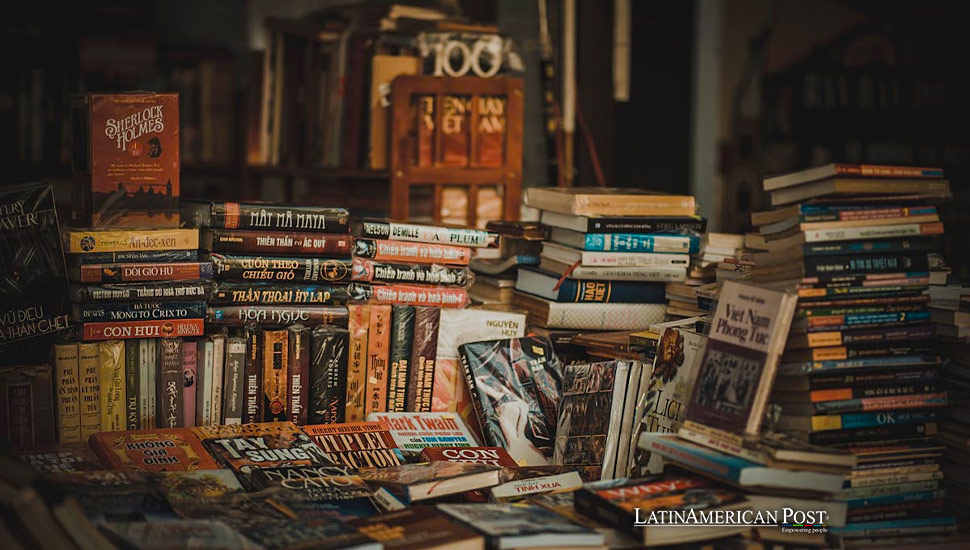Latin American Authors Say Printed Books Will Survive Despite Digital Age

Renowned authors Leonardo Padura and Paco Ignacio Taibo II affirm that printed books will endure alongside digital formats, driven by technological advancements and evolving reading habits. They highlight the resilience of literature, irrespective of its format.
At a joint press conference during the Semana Negra festival in Gijón, Spain, Cuban writer Leonardo Padura and Spanish-Mexican author Paco Ignacio Taibo II made a compelling case for the survival of printed books. They both expressed confidence that good and bad stories will continue to be published in all formats, reaffirming their shared belief in the enduring value of printed books.
For over a decade, predictions of the traditional book’s demise have circulated widely, but Taibo (Gijón, 1949) asserts that this forecast has not and will not come to pass. His sentiments were echoed by Padura (Havana, 1955), who emphasized that technological advancements, while beneficial for making culture more accessible, do not threaten the existence of printed books. Both authors agree that while the growth of public transportation will boost audiobook consumption and digital reading on tablets, these formats will not displace paper books.
Known for their crime novels featuring detectives Héctor Belascoarán (Taibo) and Mario Conde (Padura), the writers acknowledged significant changes within the noir genre since its inception, primarily influenced by prominent American authors. The evolution of noir literature, from its American roots to its spread across French, Nordic, Latin American, and Spanish authors, reflects the genre’s adaptability and enduring appeal.
Padura and Taibo highlighted that, despite the increasing popularity of digital and audio formats, the tactile experience and emotional connection associated with printed books remain irreplaceable. This sentiment is powerful in Latin America, where cultural and historical contexts contribute to a deep-seated appreciation for physical books.
Literature Noir: Evolution and Influence
Taibo, founder of the Semana Negra de Gijón and director of Mexico’s Fondo de Cultura Económica, noted the significant shift in noir literature recently, marked by the emergence of numerous talented female writers. This change reshapes the genre, bringing fresh perspectives and diverse voices that enrich the literary landscape.
The noir genre has seen its American dominance wane due to an influx of high-quality works from other regions. Taibo mentioned the revitalization of the genre by Czech and Polish authors who have gained prominence since the fall of the Berlin Wall. This diversification of noir literature illustrates how the genre adapts to different cultural contexts, infusing new life into its traditional themes of crime and moral ambiguity.
Padura expressed that many authors, himself included, are moving away from the “police” label attached to their noir novels, opting instead to create “literature without any kind of surname.” This shift allows writers to explore broader themes and narratives, transcending the confines of genre-specific storytelling.
The Future of Reading in the Digital Age
Both authors foresee a promising future for reading in the digital age. They anticipate a rise in audiobook and digital reading due to the expansion of public transportation and the convenience of portable devices. However, they believe these formats will complement rather than replace printed books, leaving readers with a positive outlook on the future of reading.
The Resilience of Printed Books: A Latin American Legacy
Moreover, printed books in Latin America often symbolize resistance and identity. In countries with censorship and political repression histories, books have been powerful tools for preserving cultural heritage and promoting intellectual freedom. This cultural significance reinforces the importance of maintaining and supporting the printed book industry.
The Role of Technology in Literature
While both Padura and Taibo acknowledge the benefits of technological advancements, they emphasize the importance of balance. Digital formats make literature more accessible and affordable, allowing readers to carry entire libraries on small devices. This democratization of knowledge is a positive development, particularly in regions where access to physical books may be limited.
However, the authors caution against viewing technology as a threat to traditional books. Instead, they see it as an opportunity to reach new audiences and enhance the reading experience. By embracing digital and printed formats, the literary world can cater to diverse preferences and needs, ensuring that literature remains vibrant and relevant in the modern age.
The future of reading lies in the coexistence of various formats, each offering unique advantages. Printed books provide a sensory and emotional connection that digital formats cannot replicate, while digital books provide convenience and accessibility. On the other hand, Audiobooks bring stories to life through narration, making them ideal for commuters and multitaskers.
A Coexistence of Formats
The insights of Leonardo Padura and Paco Ignacio Taibo II highlight the enduring value of printed books in an increasingly digital world. While technology continues transforming how we consume literature, the printed book remains a beloved and irreplaceable format for many readers. Its survival is assured by its unique experiences and cultural significance, particularly in Latin America.
Also read: Latin America’s Cryptocurrency Boom Reflects Economic Pressures and Opportunities
As the literary landscape evolves, it’s crucial to embrace the coexistence of various formats. By recognizing the strengths of print, digital, and audiobooks, we can ensure that literature remains accessible, diverse, and engaging for all. The future of reading is not about choosing one format over another but appreciating the richness each brings to our literary journey, promoting inclusivity and diversity in the literary world.




